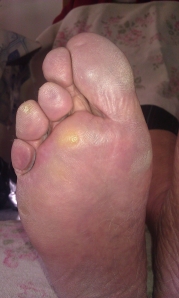Care of Corns and Calluses
Corns and calluses can cause much discomfort and frustration for clients seen by McDermott Footcare. Clients often say that the pain caused by corns and calluses limits their participation in daily and social activities.
What is a corn?
A corn, or heloma, is a thickened area of dry skin that has a visible centre, or nucleus, at the area of greatest pressure. It is caused by direct pressure from shoes upon a bony surface of the foot. The centre, or nucleus, presses on nerve endings in the skin. If it is large enough, it can be quite painful.
Soft corns form between toes, caused by direct pressure from neighbouring toes.
In this case, the skin between the toes is moist. 
In the picture, two large, painful corns are visible – one on the ball of the foot underneath the third toe and one on the tip of the fourth toe.
What is a callus?
A callus (tyloma) is an area of hardened skin caused by shearing friction – a constant rubbing back and forth – over the heels, balls of the foot and along the sides of bony areas of the foot. The hardened areas may be whitish, yellowish or brownish in colour. The picture shows callus formation around the corn on the ball of the foot, on the area underneath the big toe, and on the side of the big toe.
Common Causes of Corns and Calluses
- ill-fitting shoes are the biggest culprit – shoes that are too tight, too small, too big, too high, squish the toes, lack cushioning, have seams that rub against the foot
- structural deformities of the foot such as hammertoes and bunions that rub against the inside of the shoe. Part of the problem are shoes that don’t accommodate the deformity.

- walking too much on the outside of the foot (oversupination)
- walking too much on the inside of the foot (overpronation)

Preventing Corns and Calluses
- wear supportive, well cushioned shoes that fit well. Wear socks that absorb moisture. For tips on buying shoes and socks, read here.
- daily washing, exfoliating and moisturizing the feet
- if overpronation or oversupination is a concern, a chiropodist or pedorthist can fit you with corrective orthotics
Home Remedies for Corns and Calluses
Home remedies for treating dry, cracked heels work well for getting rid of corns and calluses since both are caused by a build-up of dry skin. Read 8 tips for dry, cracked heels here.
Avoid over-the-counter medicated corn and callus pads since the acid in these pads can irritate healthy skin around the affected area. A u-shaped, unmedicated pad is fine for corns since it avoids putting direct pressure on the area. Using razor blades and other sharp objects to cut away corns or calluses is just plain unsafe…..enough said.
Corns and Calluses in Diabetics
Diabetics must be extra careful with corns and calluses. Because of poor circulation and decreased nerve functioning in the feet, diabetics have an increased risk of infection from corns and calluses. The same applies to anyone who is not diabetic but has poor circulation or decreased nerve sensitivity in the feet. Self-care of corns, calluses and other foot problems could put you at risk for infections and trauma. Seek out the care of a certified foot care nurse who is trained in diabetic foot care such as at McDermott Footcare.
Copyright Terry McDermott. May not be reproduced in whole or in part without permission of author
Very informative, thank you for sharing.
My pleasure. Thanks for reading!
This post is nice. You have shared nice information on this. I liked preventions and care.
Thank you.